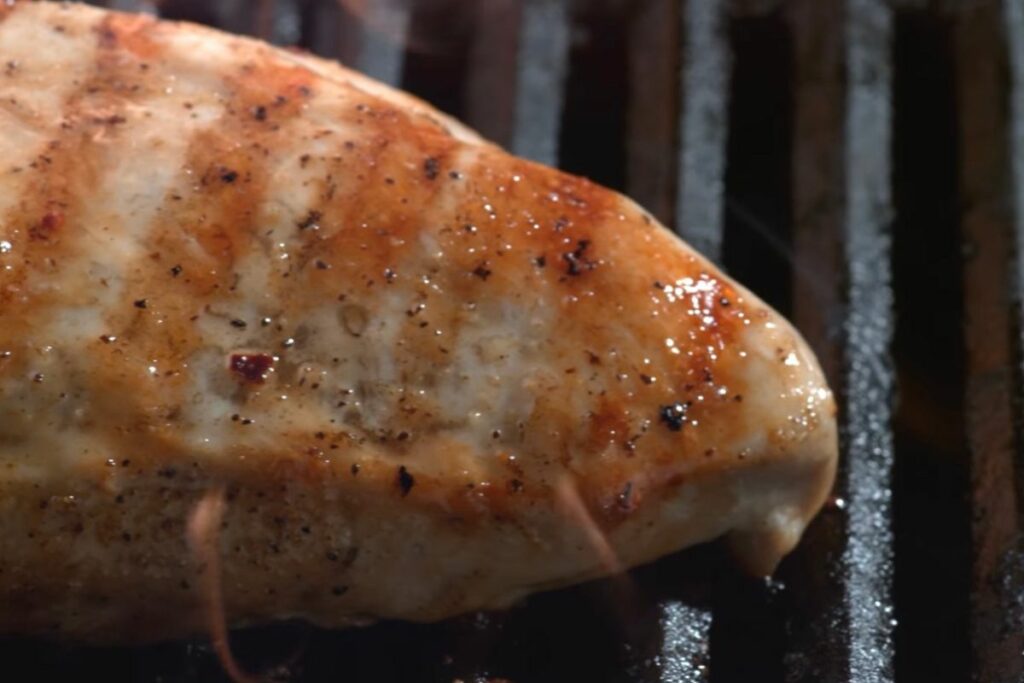Chicken is delicious, but it also comes with its own set of problems. Chewy chicken is exactly what you wouldn’t want when your meal arrives at your plate, but what can you do about it?
Unfortunately, chewy chicken is a common issue, and likely one that you have experienced before. But don’t worry; there are ways to prevent or minimize the issue. Read on for our tips on how to avoid chewy chicken and never deal with the rubbery texture again!

What Is Chewy Chicken?
Chewiness is an unfortunate side effect of cooking poultry products. The term “chicken” is often used interchangeably with birds by the American public, however chickens come in many sizes, shapes, colors and breeds.
This means that not all kinds of chicken will be equally textured once cooked due to variations in size and composition. Larger cuts like thighs tend to dry up more than breasts during cooking because they take longer to cook and hold heat better.
Smaller cuts of meat like tenderloins stay juicier than large breasts and drumsticks because they take less time to cook. Breeds include both heritage (also called local) and hybrid varieties.
Heritage chickens are raised around the country in small coops and fed traditional diets and are considered superior to commercial hybrids. In general, heritage breeds are leaner and healthier than their counterparts.
However, if you’re looking for the best of both worlds, you’ll want to choose a bird from a hybrid breed and raise it yourself.
The texture of chicken breast meat is affected by a number of factors including the type of bone structure, the amount of fat covering the muscle tissue, and overall temperature of the meat as the protein denatures (or changes shape).
When properly cooked, meat should be firm enough to chew without being tough or too soft to bite into easily. The same things happen to chicken thighs and legs after they’ve been cooked.
They get a little tougher, so they need to be served over salads or mixed in a dish with other proteins that give them the support they need to keep their integrity intact.
The key to avoiding chewy chicken is to know which parts of the body makeup the particular cut of chicken you prefer, and understanding why these elements cause this phenomenon.
After learning where the various components of your meat contribute to its chewiness, you can then work towards minimizing the impact they have on your finished product.
Woody Breast
It is possible that your chicken is chewy due to a muscle condition known as Woody Breast. Woody Breast in chickens means that the muscles are made up mostly of connective tissues rather than regular muscle fibers.
If you look at the cross-section of your chicken’s muscle, you may notice some white areas among the darker brownish areas. These areas mark out the fibrous nature of the muscle, instead of those containing striated muscle cells.
This happens as a result of genetic mutations. Though most people are unaware of this fact, it is actually quite normal. Birds are born genetically flawed, and though there isn’t much we scientists know about exactly how it works, many experts agree it has something to do with the way DNA is replicated when a cell divides.
As the parent cell creates two daughter cells, it passes on only half of its genes to each child. Instead of creating new healthy muscle fibers, one daughter cell loses the ones it inherited and ends up forming more of the connective tissue found in Woody Breast.
Can You Get Rid of the Chewy Texture Yourself?
You may be wondering if it is at all possible to get rid of, or at least reduce, the chewiness of the chicken if you do find yourself with a bird that isn’t ideal. Of course, you might only notice this after you have cooked the bird, but can you do anything about it?
To get rid of the chewy texture in chicken, you could start by making sure you are serving it with something else in the first place. If you absolutely must eat the chicken straight away, try mixing it with sauces or dressings that won’t leave it soggy.
Or, you could always make sure you are using smaller pieces of chicken, such as thigh meat. Remember that larger joints contain proportionally more connective tissues and cartilage than smaller ones, so they will often develop a bit of chewiness when cooked.
How To Reduce Its Impact On Your Meal?
When you’re working with raw meats, some moisture will quickly evaporate, leaving behind a crisp crust. But when you are taking time to cook a piece of chicken, the meat’s natural water content will slowly release, allowing the food to stick together instead of fall apart, which contributes to the problem of chewy chicken.
As mentioned before, there are two primary culprits within our poultry species: bones and muscles. Bones add chewiness in several ways.
First off, bones are hollow (not unlike the tubes in an apple), which means they are much lighter than solid chunks of beef or pork.
While this makes sense when calculating volume, what it does not account for is surface area. A relatively large chunk of beef has a lot more surface area to hold onto liquid than a tiny bone.
So while bones aren’t exactly dense, they act like sponges, soaking up moisture from the surrounding environment and pulling it toward themselves. In turn, this makes the piece of chicken feel wetter than it would otherwise be.
Muscle also adds a lot of chewiness to a piece of meat simply because it contains collagen, a material that holds onto moisture and prevents foods from drying out.
This effect is intensified during cooking, when the heat breaks down bonds between amino acids in collagen – making collagen seem even stronger and giving the whole thing a chewier texture. White meat should be cooked at 165 degrees to get the best results.
Tenderizing Woody Chicken Breast
If you see that the chicken you have matches the description of woody chicken breast, you can try tenderizing it. Although this is unlikely to solve the problem entirely, it will help make the chicken more tasty and palatable.
To do this, you can try using a marinade made with chili powder to flavor the chicken and then baking it on a cookie sheet covered in foil.
The heat from the oven will break down the collagen in the chicken, making it taste less fibrous and less ‘woody’. For extra credit, toss in a pinch of cayenne pepper to spice things up!
You could also try using a marinade of yogurt or buttermilk to help, as these will help break down the enzymes to tenderize the meat. This is a great method if you intend on frying the chicken.
Alternatively, you can use a meat mallet tenderizer on your chicken to break down the protein fibers. You should ensure that the meat is removed from the bone and covered in plastic wrap to avoid making a mess.
Cooking Methods to Reduce Chewy Chicken
There are some cooking techniques you can use to reduce the impact of chewy or woody chicken. Below are some things you can try to make your chicken meat as tender as possible.
Steaming
You also have the option is to steam the meat. Steaming preserves juices better than other methods, so you’ll definitely want to use this technique if you plan on making chicken salad later on.
Steam the chicken breasts right after removing them from the freezer and let them cool completely before gently removing them from their packaging. Use paper towels to blot any excess moisture from the breasts until they are dry.
Once the pieces are dry, place them in either a bamboo steamer or a saucepan filled with about eight inches of boiling water.
Cover the pan and bring the water back to a boil; reduce the heat to low and simmer the chicken for 20 minutes. Remove the lid from the pot for the last five minutes of cooking to allow the chicken to brown slightly. Serve immediately.
Velvet Chicken
You could also try making velvet chicken – a popular restaurant method. To make velvet chicken, you need to first cut your chicken breast into cubes approximately 1-inch wide. Then, beat the white of one egg in a bowl. Add a teaspoon of cornstarch and a tablespoon of soy sauce.
Transfer the mixture into a Ziploc back and add the cubed chicken. Allow the chicken to marinate for approximately 30 minutes, then poach it in salted water for around 3 minutes, or until the chicken has cooked and turned white.
Once the meat is cooked, strain it and pat away the excess moisture. It can then be served how you choose.
Final Thoughts
Unfortunately, chewy chicken is not something that we can actively avoid. This is especially the case if you are unsure of what to look out for. However, there are some things you can do to reduce the impact of this unpleasant occurrence on you.
By following the methods set out above, you can combat the woody chicken breast and get delicious, tender meat every time. Although it takes some extra time, the results are well worth it.
- Porterhouse Vs. Ribeye - May 16, 2022
- How Long To Smoke A Brisket Per Pound – Explained - May 16, 2022
- What Is A Tomahawk Steak? - May 16, 2022








